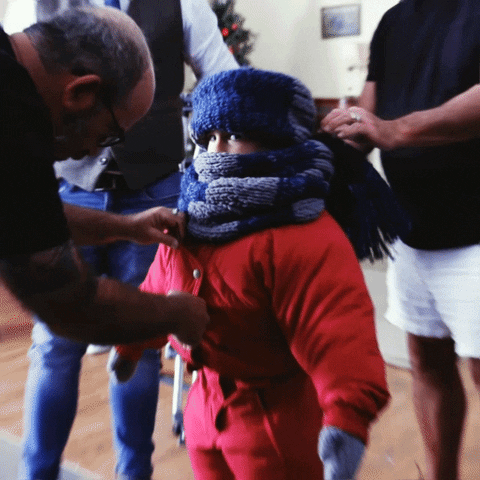Today’s forecast: “I can’t feel my face” degrees!
So, you’re getting ready to brave your first winter in Canada.
First things first, welcome! Everyone at Humber and UofGH is so happy to have you here.
We’re not going to sugar-coat it; Canadian winters are long and can be really cold. That being said, it can also be really beautiful with so much to look forward to. Some of the best things that come to mind are the number of seasonal activities and events to enjoy—witnessing beautiful snowfalls, playing winter sports, making snowmen, drinking hot chocolate, relaxing over winter break and so much more.
However, if you’ve never experienced a Canadian winter before, it can definitely be both a daunting and exciting prospect.
So, if you’re excited about the upcoming winter but not sure how to start preparing, we’re here to help with a rundown of everything you’ll need to survive! Let’s get into it:
What is winter like in Toronto?

The Canadian winter varies quite a bit depending on where you are in the country.
In the Toronto area, winter weather is usually a little milder than in most other Canadian cities; however, you can count on it still being cold and snowy with an often impressive wind-chill factor.
The cold weather will generally start picking up in November with the winter officially starting in December and lasting until late March or early April. In total, you’re in for approximately five to six months of cold weather.
Temperatures will usually be below or around zero degrees Celsius and tend to linger between -5 and -15 degrees Celsius. However some days it can be even lower reaching as low as -20 or -30 degrees Celsius largely due to wind chill.
You can expect to witness your fair share of snowfalls in the Toronto area, however, compared to other areas of the country (or even just north of the GTA), icy rain and slush tend to be a lot more common — making your shovelling duties at least a little easier.
What should I wear?

Layers, layers, layers
Layering to stay warm is very important; however, it can be a little inconvenient as soon as you’re inside and away from the cold. It’s a love-hate relationship.
That being said, it can also be fun to play around with your layering. It’s more than possible to be fashionable and warm—so avoid sacrificing one for the other by not wearing the right number of layers. (Ask any Canadian-raised student; we all did it as teens and regretted it while freezing on the school playground.)
Some key items you should consider getting are:
- a winter coat (preferably waterproof)
- a hat (also known as a toque)
- ear muffs
- mittens and gloves
- a scarf
- thick socks
- snow boots (with non-slip soles for the icey sidewalks)
- sunglasses (to protect your eyes from the glare of the sun on the snow)
- snow pants
- thermal underclothes (for those extra chilly days)
- hand warmers
Quality counts
If you’re able to spend a little extra upfront, buying good quality products will be a lifesaver over the winter months.
Not only will your quality items last you the whole winter and (hopefully) for many winters to come; but you’ll also likely notice a significant difference in their warmth compared to cheaper finds.
Is it normal to feel down during the winter?

Absolutely.
If you’re coming to Canada from a country where winter is not a cold season, you might not be familiar with the winter blues. It doesn’t affect everyone but, if over the winter months find yourself feeling down due to the seasonal changes, you’re not the only one!
Luckily there are many ways to beat the winter blues:
- Take part in events and activities
- Eat smart and take multivitamins
- Set goals
- Find hobbies that make you happiest
And, when those aren’t enough, never be afraid to ask for help.
Consider speaking with your doctor or reaching out to on-campus resources.
The Student Wellness and Accessibility Centre offers free, confidential counselling to all students at Humber and UofGH. It’s currently conducting appointments virtually; you can book yours by emailing [email protected].
The weather outside may be frightful, but your mental health doesn’t have to be!
A couple more important things to keep in mind

Get your car winter ready
If you’re planning on driving to and from campus, make sure that your car is ready to face the winter ahead.
- Get your winter tires installed.
- Make sure the basics—like your heater, battery and wiper blades—are working well and that your washer fluid is topped off (pro tip: make sure you buy washer fluid that’s suitable for cold temperatures and don’t forget to keep a bottle of it in your trunk in case you run out).
- Install floor mats to keep your car clean from salts, slush and snow.
- Get at least one snowbrush with an ice scraper.
- Prep a winter emergency kit.
Plan extra time into your commute
When travelling to and from school over the winter, delays are to be expected no matter if you’re taking transit or driving. Make sure to schedule extra time into your commute so that when you need to be somewhere on time, you can get there without stressing or getting into any trouble.
Check weather apps regularly
Canadian winters can be unpredictable. Check your weather apps regularly to make sure that when you leave the comfort of your home, you’re ready for all that might be waiting for you!

Now you’re all ready to face the Canadian winter. And, despite the cold, winters in Canada are truly one of a kind—so make the most of the season and enjoy all it has to offer.
Whether you’re moving across the street or across the globe, vigilance is important. Steer clear of these six red flags when apartment hunting.
Follow IGNITE on Facebook, Instagram and Twitter for all things student life.
